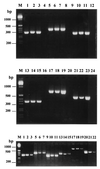PCR assays that identify the grapevine dieback fungus Eutypa lata
- PMID: 11010901
- PMCID: PMC92327
- DOI: 10.1128/AEM.66.10.4475-4480.2000
PCR assays that identify the grapevine dieback fungus Eutypa lata
Abstract
Eutypa lata is the causal fungal agent of Eutypa dieback, a serious grapevine necrotic disease. The erratic and delayed (1 to 2 months) appearance of characteristic conidia on culture media and the presence of numerous microorganisms in decaying wood make it difficult either to identify or to detect E. lata in grapevine wood samples. We designed six pairs of PCR primers for diagnosis of E. lata. Three primer pairs were derived from ribosomal DNA internal transcribed spacer sequences, and three pairs were derived from randomly amplified polymorphic DNA fragments. The six primer pairs could be used to amplify DNAs extracted from all of the E. lata isolates tested. They did not amplify DNAs from fungi and bacteria representing more than 50 different species of microorganisms associated with grapevine. We developed a simple protocol, leading to a rapid release of DNA, that enabled us to identify E. lata from pure or mixed cultures as well as from grapevine wood samples. Identification of E. lata in wood was achieved within a few hours, instead of the several weeks required for classical cultures on agar medium. We believe that the procedure described here can be adapted to detect other microorganisms involved in woody plant diseases.
Figures


Similar articles
-
Phytotoxins produced by fungi associated with grapevine trunk diseases.Toxins (Basel). 2011 Dec;3(12):1569-605. doi: 10.3390/toxins3121569. Epub 2011 Dec 20. Toxins (Basel). 2011. PMID: 22295177 Free PMC article. Review.
-
Molecular identification and detection of Eutypa lata in grapevine.Mycol Res. 2005 Jul;109(Pt 7):799-808. doi: 10.1017/s0953756205002893. Mycol Res. 2005. PMID: 16121566
-
Detection of Eutypa lata and Eutypella vitis in Grapevine by Nested Multiplex Polymerase Chain Reaction.Phytopathology. 2007 Jun;97(6):737-47. doi: 10.1094/PHYTO-97-6-0737. Phytopathology. 2007. PMID: 18943605
-
Diversity within natural progenies of the grapevine dieback fungus Eutypa lata.Curr Genet. 1999 Nov;36(5):301-9. doi: 10.1007/s002940050504. Curr Genet. 1999. PMID: 10591971
-
Metabolites from Eutypa species that are pathogens on grapes.Nat Prod Rep. 2006 Feb;23(1):108-16. doi: 10.1039/b514891j. Epub 2005 Nov 28. Nat Prod Rep. 2006. PMID: 16453034 Review.
Cited by
-
Quantitative Assessment of Grapevine Wood Colonization by the Dieback Fungus Eutypa lata.J Fungi (Basel). 2017 May 6;3(2):21. doi: 10.3390/jof3020021. J Fungi (Basel). 2017. PMID: 29371539 Free PMC article.
-
A Panoramic View on Grapevine Trunk Diseases Threats: Case of Eutypa Dieback, Botryosphaeria Dieback, and Esca Disease.J Fungi (Basel). 2022 Jun 1;8(6):595. doi: 10.3390/jof8060595. J Fungi (Basel). 2022. PMID: 35736078 Free PMC article. Review.
-
Phytotoxins produced by fungi associated with grapevine trunk diseases.Toxins (Basel). 2011 Dec;3(12):1569-605. doi: 10.3390/toxins3121569. Epub 2011 Dec 20. Toxins (Basel). 2011. PMID: 22295177 Free PMC article. Review.
-
Development of specific sequence-characterized amplified region markers for detecting Histoplasma capsulatum in clinical and environmental samples.J Clin Microbiol. 2012 Mar;50(3):673-9. doi: 10.1128/JCM.05271-11. Epub 2011 Dec 21. J Clin Microbiol. 2012. PMID: 22189121 Free PMC article.
-
A transcriptomic study of grapevine (Vitis vinifera cv. Cabernet-Sauvignon) interaction with the vascular ascomycete fungus Eutypa lata.J Exp Bot. 2010 Jun;61(6):1719-37. doi: 10.1093/jxb/erq040. Epub 2010 Feb 26. J Exp Bot. 2010. PMID: 20190040 Free PMC article.
References
-
- Altschul S F, Gish W, Miller W, Myers E W, Lipman D J. Basic local alignment search tool. J Mol Biol. 1990;215:403–410. - PubMed
-
- Bell C R, Dickie G A, Harvey W L G, Chan J W Y F. Endophytic bacteria in grapevine. Can J Microbiol. 1995;41:46–53.
-
- Bolay A, Carter M V. Newly recorded hosts of Eutypa lata (=E. armeniacae) in Australia. Plant Prot Q. 1985;1:10–12.
-
- Carter M V. Eutypa dieback (“Dying arm”) disease of vines—progress towards control. Aust Grapegrower Winemaker. 1978;172:27–28.
-
- Carter M V. The status of Eutypa lata as a pathogen. International Mycological Institute, Phytopathological Paper 32. Wallingford, England: CAB International; 1991.
Publication types
MeSH terms
Substances
LinkOut - more resources
Full Text Sources
Other Literature Sources

